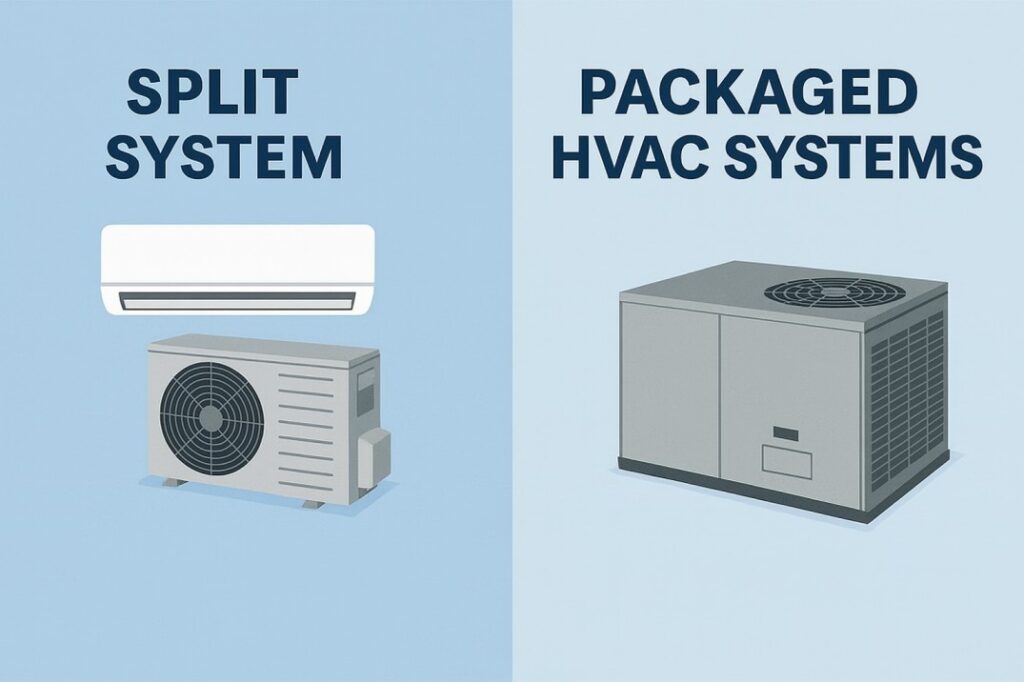Choosing the correct heating and cooling system is crucial for maintaining comfort, conserving energy, and ensuring your equipment operates efficiently for years. When it’s time to replace an outdated unit or set up a new house, most owners end up weighing two main options: a split system HVAC and a packaged HVAC system.
In this article, we’ll break down the good and bad of each choice and glance at a few other setups so you can find the one that really fits your space and budget.
What Is a Split System HVAC and How Does It Work?
The split system HVAC is the workhorse of American homes. As the name suggests, it splits its main parts between indoor and outdoor locations, letting each perform best where it lives.
Components and Installation
- Outdoor unit: sits outside and holds the compressor and condenser coil.
- Indoor unit: fits inside and holds the evaporator coil plus the air handler or furnace, if heating is needed.
Refrigerant lines connect the two units and circulate refrigerant to enable heat exchange. This setup is typically found in residential HVAC systems, especially where homes have sufficient indoor utility space.
Pros and Cons of Split System HVAC
Pros:
Higher energy efficiency ratings
Quiet indoor operation.
Easier to repair individual components
Cons:
The system needs a bigger space to be installed in.
A little more money up front for installation
What Is a Packaged HVAC System?
A packaged HVAC system is an all-in-one unit that contains all heating and cooling components within a single outdoor cabinet. Typically, people install it on the roof or a concrete pad adjacent to the home.
Components and how they differ from split systems
Unlike split systems, there’s no separate indoor unit. Everything, the blower, coils, compressor, and motor, is integrated into a single compact cabinet. A packaged air conditioner connects directly to the ductwork, just like a central air system.
Pros and Cons of Packaged HVAC Systems
Pros:
Great for households with little space inside
Installation is easier and faster.
Lower initial expenses for equipment and labor
Cons:
Slightly less efficient than split systems
Exposed to outdoor elements, which may affect longevity
Split AC vs Central AC: Clearing Up the Confusion
There’s often confusion between a split AC and central AC, so let’s clarify.
- A split air-conditioning system is still a type of central AC. It sits in two units, an indoor air handler and an outdoor compressor, and runs ductwork throughout the house, available through trusted HVAC supply in Beaumont TX providers.
- A packaged air conditioner, in contrast, packs all the parts into one cabinet, making it easier to install on a roof or a pad next to the house.
So when people argue split AC vs central AC, they are really talking about the same family of systems. The big difference is where the parts sit and how they tie together.
Types of HVAC Systems Explained
Before buying, homeowners should know the main types of HVAC systems on the market:
- Split System HVAC. As mentioned above, it moves cooled air through ducts after splitting the indoor and outdoor parts. It works best in suburbs or larger homes.
- Packaged HVAC System. Because every piece is inside one box, this system is perfect for small houses or places with no room for attic equipment.
- Ductless Mini-Split Systems. If a home has no ducts, these setups let each room have its own air handler linked to one outdoor compressor.
- Hybrid Split Systems. By mixing gas heat with electric heat, these units switch sources to save energy when the weather changes.
- Heat Pump Systems. A heat pump cools in summer and heats in winter by reversing the flow of refrigerant, making it popular in mild regions.
There are many different kinds of heating and cooling systems, split system HVAC and packaged HVAC systems still lead the pack in U.S. residential HVAC systems.
Which System Is Right for Your Home?
Before you decide, think about your rooms, budget, and local weather.
Consider a split system if:
- You want a more energy-efficient solution.
- You have enough indoor space for a furnace or air handler.
- You value lower noise levels during operation.
- You’re comfortable with a slightly more complex installation.
Consider a packaged system if:
- You have limited interior space.
- You want a simpler, faster installation.
- You live in a warmer climate where heating needs are minimal.
- You prefer a more compact setup.
Because packaged air conditioners house all components outdoors, they work wonders in tight spots or mobile homes. Split system HVAC, however, spreads equipment inside and out, giving larger houses sharper control and often better long-term savings. Read our Guide Before Buying an AC to make an informed decision.
Final Thoughts
In the end, both split system HVAC and packaged HVAC system styles will heat and cool your home, so weigh layout, comfort, and future costs to find the fit that benefits you most.
If you’re stuck choosing between split AC and central AC, know that either will cool your home. They just do it in different ways, and each offers its level of reach and adjustability.
Getting clear on how these types of HVAC systems work will help you pick with confidence. Still, chatting with a trained HVAC pro is smart; They’ll check your house and point you to the setup that fits you best. Contact us to get started with the right HVAC solution.


